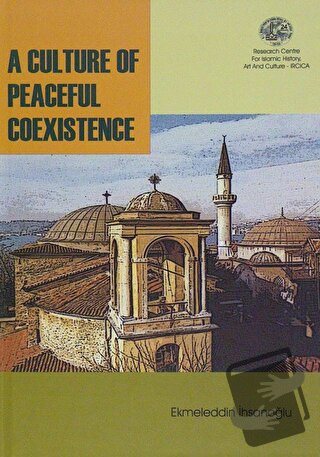
This treatise is a revised and expanded version of a lecture presented at the East-West Forum organized by the US based East-West Institute’s Eurasia Strategy Group and IRCICA and held on 19 October 2002 at IRCICA, Istanbul. This study focuses on the Islamic culture of peaceful coexistence with particular reference to the history of Islamic civilization and especially the Ottoman world. In the introductory chapter the author deals with the conceptual frameworkandthephilosophybehindthereligious-culturalpluralism in theIslamic tradition.Thefollowingchapterdemonstrates thetolerant attitudeof Islam towards JewsandChristians (the Ahlal-Kitab)byquotingtherelevant Qur’anic versesandpointingout that the membersof someother religions such as Zoroastrians, Hindus, Buddhists, etc. were considered as protected minorities after the Islamic expansion. In this study one also finds a brief discussion of the earliest example of pluralism in Islam, i.e. the Medina Constitution which was promulgated by the Prophet after his emigration from Mecca to Medina in 662 A.D. The followingchaptergives examplesofpluralism duringtheperiodof the four caliphs as well as citingthe viewsof the major schoolsof Islamic jurisprudenceon this subject. The followingchaptersof the treatisedeal with subjects such as the responsibilities of non-Muslims (the payment of the jizyah, kharaj and trade tax as financial obligations); a discussion of the millet system and its application in different periods of Ottoman rule through examples; the developments that occurred after the declaration of the Imperial Rescript of Tanzimat in 1839, and the rights and responsibilities of non-Muslims. The last chapter of the work gives three living examples of religious-cultural pluralism and peaceful coexistence of various faiths and cultures from Istanbul. Here, the author firstly dwells on the Darülaceze Complex, secondly and thirdly the Kuzguncuk and Ortaköy districts where religious buildings of peoples of different faiths stand next to each other. In the epilogue the study underlines the significance of thepeaceful coexistence ofpeoples ofdifferent faiths andcultures for today’s world where there is agreat needforpeace.
| Taksit Sayısı | Taksit tutarı | Genel Toplam |
|---|---|---|
| Tek Çekim | 170,00 | 170,00 |
| 3 | 61,93 | 185,78 |
| 6 | 32,69 | 196,16 |
| 9 | 22,95 | 206,57 |
| 12 | 18,08 | 216,94 |
| Taksit Sayısı | Taksit tutarı | Genel Toplam |
|---|---|---|
| Tek Çekim | 170,00 | 170,00 |
| 3 | 61,93 | 185,78 |
| 6 | 32,69 | 196,16 |
| 9 | 22,95 | 206,57 |
| 12 | 18,08 | 216,94 |
| Taksit Sayısı | Taksit tutarı | Genel Toplam |
|---|---|---|
| Tek Çekim | 170,00 | 170,00 |
| 3 | 61,93 | 185,78 |
| 6 | 32,69 | 196,16 |
| 9 | 22,95 | 206,57 |
| 12 | 18,08 | 216,94 |
| Taksit Sayısı | Taksit tutarı | Genel Toplam |
|---|---|---|
| Tek Çekim | 170,00 | 170,00 |
| 3 | 61,93 | 185,78 |
| 6 | 32,69 | 196,16 |
| 9 | 22,95 | 206,57 |
| 12 | 18,08 | 216,94 |
| Taksit Sayısı | Taksit tutarı | Genel Toplam |
|---|---|---|
| Tek Çekim | 170,00 | 170,00 |
| 3 | 61,93 | 185,78 |
| 6 | 32,69 | 196,16 |
| 9 | 22,95 | 206,57 |
| 12 | 18,08 | 216,94 |
| Taksit Sayısı | Taksit tutarı | Genel Toplam |
|---|---|---|
| Tek Çekim | 170,00 | 170,00 |
| 3 | 61,93 | 185,78 |
| 6 | 32,69 | 196,16 |
| 9 | 22,95 | 206,57 |
| 12 | 18,08 | 216,94 |
| Taksit Sayısı | Taksit tutarı | Genel Toplam |
|---|---|---|
| Tek Çekim | 170,00 | 170,00 |
| 3 | - | - |
| 6 | - | - |
| 9 | - | - |
| 12 | - | - |
This treatise is a revised and expanded version of a lecture presented at the East-West Forum organized by the US based East-West Institute’s Eurasia Strategy Group and IRCICA and held on 19 October 2002 at IRCICA, Istanbul. This study focuses on the Islamic culture of peaceful coexistence with particular reference to the history of Islamic civilization and especially the Ottoman world. In the introductory chapter the author deals with the conceptual frameworkandthephilosophybehindthereligious-culturalpluralism in theIslamic tradition.Thefollowingchapterdemonstrates thetolerant attitudeof Islam towards JewsandChristians (the Ahlal-Kitab)byquotingtherelevant Qur’anic versesandpointingout that the membersof someother religions such as Zoroastrians, Hindus, Buddhists, etc. were considered as protected minorities after the Islamic expansion. In this study one also finds a brief discussion of the earliest example of pluralism in Islam, i.e. the Medina Constitution which was promulgated by the Prophet after his emigration from Mecca to Medina in 662 A.D. The followingchaptergives examplesofpluralism duringtheperiodof the four caliphs as well as citingthe viewsof the major schoolsof Islamic jurisprudenceon this subject. The followingchaptersof the treatisedeal with subjects such as the responsibilities of non-Muslims (the payment of the jizyah, kharaj and trade tax as financial obligations); a discussion of the millet system and its application in different periods of Ottoman rule through examples; the developments that occurred after the declaration of the Imperial Rescript of Tanzimat in 1839, and the rights and responsibilities of non-Muslims. The last chapter of the work gives three living examples of religious-cultural pluralism and peaceful coexistence of various faiths and cultures from Istanbul. Here, the author firstly dwells on the Darülaceze Complex, secondly and thirdly the Kuzguncuk and Ortaköy districts where religious buildings of peoples of different faiths stand next to each other. In the epilogue the study underlines the significance of thepeaceful coexistence ofpeoples ofdifferent faiths andcultures for today’s world where there is agreat needforpeace.




















